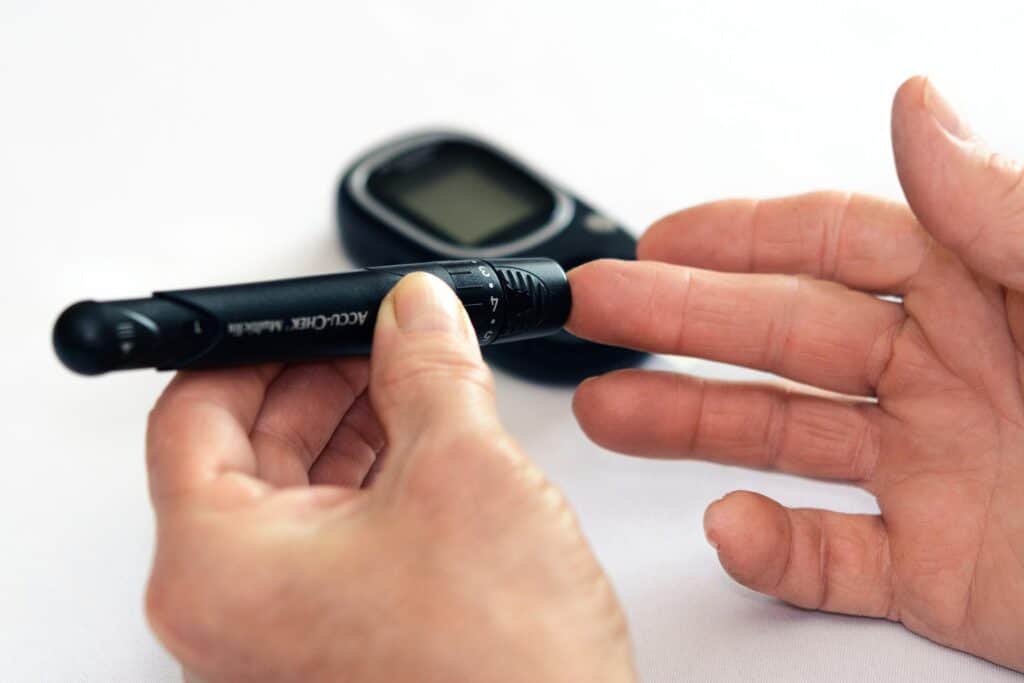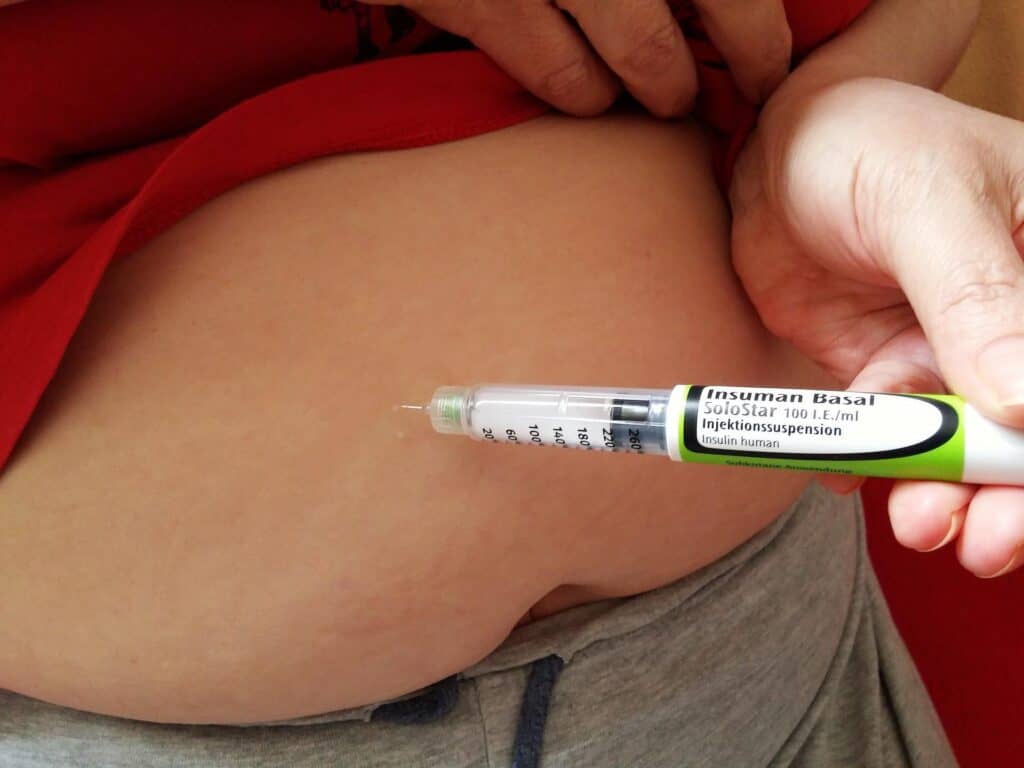THE MEDICAL BLOG
August 15, 2022 – By Dr. Haider Khalid

There are many Warning Signs of Diabetes. Diabetes is a long-standing illness affecting about 10% of the US population (1). It is a disease characterized by an abnormality in blood sugar levels, increasing the risk of several complications. Therefore, you must manage your blood sugar levels within normal limits to avoid these complications.
Most people usually remain concerned about the telltale signs of diabetes. But unfortunately, high blood sugar levels can sneak up on you without showing signs and symptoms. That feature makes diabetes one of the biggest health concerns globally.
This article explains the common warning signs associated with diabetes. However, before that, you must understand its two types because the symptoms and causes of these types differ significantly.
What are the Types of Diabetes?
In the human body, insulin is the primary hormone that keeps blood sugar levels within normal limits. Therefore, any damage to the functions of insulin can lead to impaired glucose management, which happens in both types of diabetes, Type 1 and Type 2.
In type 1 diabetes, genetic and immunological factors are significant. In this type, the body shows an immune response against the pancreas. Destruction of the pancreas leads to lower insulin levels (2). Conclusively, the blood sugar levels of the patient rise above normal limits. Due to genetic factors, the patient usually presents with symptoms in childhood or adolescence.
The mechanism of the diseased process in type 2 diabetes is pretty fascinating. In this type, the pancreas produces an average amount of insulin. Still, your body fails to respond to it, leading to impaired insulin function (3). The reduced sensitivity of the body to insulin action is because of the presence of risk factors that have damaged the body over the years. Therefore, patients with type 2 diabetes usually present with warning signs in adulthood.
How Do You Know if You Have Diabetes?
As discussed before, most people don’t present with any signs. Therefore, in the early stages of the disease, it is challenging to tell if you have diabetes. The best way to know if you have diabetes is to get tested for blood sugar or plasma HbA1c levels. You will also learn the significance of both tests later in the article.
However, here in this portion, you will learn about the common warning signs through which you can know if you have diabetes or not.
Early Warning Signs
Signs and symptoms of diabetes occur due to long-standing organ and tissue damage with high blood sugar levels. Therefore, you need to consult with your healthcare provider if you notice warning signs of diabetes. If you don’t pay attention to these signs, you will have to face severe organ damage.
According to the Centers for Disease Control, some of the common early warning signs of diabetes include (4),
- Extreme thirst and frequent urination, especially at night
- Weight loss regardless of increased hunger
- Blurring of vision
- Itchy and dry skin
- Numbness and tingling in limbs, especially in toes and fingers
- Poor wound healing
Warning Signs of Type 1 Diabetes

Even though both types of diabetes present with high blood glucose levels, there is a slight difference in their warning signs. Knowing the difference can help you know which type of diabetes you suffer.
Most importantly, the warning signs of type 1 diabetes appear within a limited phase of time, usually weeks or months (5). Therefore, the patients of this type are primarily in the first or the second decade of their life. According to research, diagnosis of type 1 diabetes mainly occurs in children of 4 to 6 and 10-14 years old (6).
In addition to the early warning signs mentioned above, children with type 1 diabetes can also show some of the following additional symptoms,
- Uncontrolled weight loss
- Bedwetting due to frequent uncontrolled urination
- Increase incidence of yeast infections
- Fruity smell due to presence of ketone bodies
In uncontrolled type 1 diabetes, a particular kind of compound – ketone bodies – pools in the blood. Excessive blood pooling with ketone bodies is known as diabetic ketoacidosis, a medical emergency (7). The patient may go into a coma if doctors don’t timely manage this condition. In mild cases, patients with high levels of ketone bodies in the blood present flu-like symptoms.
Warning Signs of Type 2 Diabetes
If you have type 2 diabetes, there are chances that your warning signs will appear gradually. Most of the symptoms take even years to appear (4). Moreover, there are chances of having a subtle disease, in which you will not even experience a single finding in your body related to the disease.
Due to its subtle nature, you would remain unaware of your health condition in type 2 diabetes. However, the disease will slowly damage multiple organs of your body. That is why later in the disease, patients with type 2 diabetes present signs related to numerous organs that don’t have any association with each other.
Understanding Signs of Diabetes
Now you will learn comprehensive scientific knowledge about most of the significant symptoms of diabetes. It will help you understand your disease better.
Even after high blood glucose levels, the body cannot utilize it. This phenomenon is responsible for the increased hunger and fatigue in diabetes patients.
Kidneys must remove all the extra glucose in your body to prevent tissue damage. However, removal of excess glucose requires unnecessary removal of extra water, which is responsible for frequent urination and excessive thirst.
High blood glucose levels can even damage your immune system (8). Poor immune function increases the risk of infectious diseases in people with diabetes. Therefore, yeast infections such as oral thrush are more common in these people. Healthcare providers advise people with diabetes to get vaccinated for common infectious diseases (9).
Another common complication related to diabetes is diabetic neuropathy. High blood sugar levels damage the nerves of the body. The nerves carrying information from the distal parts of limbs are primarily affected in diabetes. Therefore, the patient usually presents with tingling, pain, or numbness in these areas. In some cases, the condition may worsen, leading to diabetic ulcers.
Similar to damaging nerves, high blood sugar also damages the eyes. Diabetes can damage your eyes in two ways. First, it can raise the pressure in your lens region, leading to glaucoma. Moreover, it also damages the internal layer of your eyeball, the retina. Damage to the retina is the common cause of blindness in diabetic patients (10).
All these are the vital warning signs you would know if you have diabetes.
Confirming the Diagnosis of Diabetes

In most cases, you would learn that you have diabetes once you notice the early warning signs. For example, unintentional weight loss in type 1 diabetes and frequent urination in type 2 diabetes can trigger you to get a medical checkup.
There are cases in which you can be diagnosed with diabetes when you visit the health clinic for some other condition. Most health clinics also evaluate blood glucose levels during general visits. You can also ask them to check your blood sugar levels if you are suspicious of your health condition.
Conclusively, if you notice any warning signs, visit your healthcare provider. He will ask you for details about your medical history, looking for essential findings to help him develop the diagnosis. Afterward, he will advise you on some tests. Some of the crucial tests that help to confirm the diagnosis of diabetes include,
- Fasting plasma glucose (FPG): In this test, you will have to check your blood glucose levels after at least 8 hours of fasting.
- Random plasma glucose (RPG): It is the random evaluation of the glucose levels in your blood.
- HbA1c: It is a natural protein that is present in the blood. In normal individuals, there is some percentage of this protein present. However, in the case of diabetes, its amount rises significantly. HbA1c evaluation gives the idea about managing blood glucose levels in the past three months. Therefore, it is an important test to develop a confirmed diagnosis.
Apart from these, an oral glucose tolerance test is also used. However, it is obsolete nowadays because it requires the patient to remain at the clinic for a long time. Therefore, always keep the list of questions you need to ask when you visit your doctor. It is an easy and effective way to remove your concerns.
What are the Risk Factors of Diabetes?
The risk factors of diabetes also depend upon its type. Type 1 diabetes is more common in children and young adults. A family member who also has the same disease is the most common risk factor associated with type 1 diabetes (11). It is an auto-immune disease. Hence, there is likely any way to prevent the disease from happening. You will have to manage it once you are diagnosed.
However, there are multiple risk factors for type 2 diabetes. Age, obesity, smoking, high blood pressure, and high blood cholesterol levels are some of the important ones. But fortunately, the presence of a single factor is not enough to cause the disease. Therefore, if you want to save yourself from diabetes, you should start focusing on reducing these symptoms.
What Does the Treatment Involve?
Diabetes is more of a health condition than a disease. Lifestyle habits have a significant effect on this condition. However, healthy lifestyle changes are not enough in the late stages to keep your blood sugar levels in check. In that case, you would need medications.
Conservative Management
The management of disease using only changes in lifestyle habits is known as conservative management. Conservative management of diabetes is far more critical than medications, especially in type 2 diabetes. If you are not controlling your risk factors, there is likely any chance that drugs would help you treat the disease.
Dietary modifications, exercise, and removal of risk factors are the three main cornerstones of diabetes management. In diabetes, you should avoid foods rich in carbohydrates and fats. Therefore, you should maintain a diet rich in fibers and proteins that can help your body grow better.
Exercise is crucial for maintaining most of your risk factors. It reduces fat levels in your blood. It helps to prevent damage to your arteries in diabetes. Moreover, it diverts the extra glucose from the blood toward the muscle. Diet and exercise can reverse the disease progression in the initial or pre-diabetic stages. Therefore, you should try focusing on these factors to live a medication-free life.
Diabetes Medications

In type 1 diabetes, your body is not making enough insulin. It would help to compensate for it from the outside. Therefore, the only medication available for type 1 diabetes is insulin injection.
In type 2 diabetes, medications become essential only when the conservative management fails to produce results. Oral medications containing metformin are the first-line treatment of diabetes. However, some doctors even prescribe insulin injections from the beginning.
Is Prevention of Diabetes Possible?
You can’t prevent type 1 diabetes. But there are significant chances of preventing type 2 diabetes. You can even reverse its progression by improving your diet and lifestyle habits. Quitting smoking and alcohol with the maintenance of a healthy weight gain can also help in the prevention of the disease.
The Conclusion
Type 2 diabetes is a slowly progressive disease. Mostly, it remains subtle and usually presents late in life. Thus, if you want to tell whether you have diabetes or not, you should look for the critical warning signs of the disease. For example, weight loss, frequent urination, and increased hunger are early warning signs of both types of diabetes.
However, the diagnosis is confirmed based on several tests, including fasting and random blood glucose levels. Once diagnosed with diabetes, you must make necessary amendments to your diet and lifestyle to minimize the risk of complications. Otherwise, severe complications can occur, jeopardizing your health.
For more information on how to manage your diabetes:
3 EFFECTIVE WAYS TO MANAGE DIABETES
8 BEST JUICE RECIPES FOR BETTER HEALTH
Become a part of our growing community today at Something Better Today.
References
1. Centers for Disease Control and Prevention. National Diabetes Statistics Report, 2017 Estimates of Diabetes and Its Burden in the United States Background [Internet]. CDC. 2020 [cited 2022 Aug 15]. Available from: https://www.cdc.gov/diabetes/pdfs/data/statistics/national-diabetes-statistics-report.pdf
2. Ziegler Anette-G, Nepom GT. Prediction and Pathogenesis in Type 1 Diabetes. Immunity [Internet]. 2010 Apr [cited 2022 Aug 15];32(4):468–78. Available from: https://www.ncbi.nlm.nih.gov/pmc/articles/PMC2861716/
3. DeFronzo RA. Pathogenesis of type 2 diabetes mellitus. Medical Clinics of North America. 2004 Jul;88(4):787–835.
4. CDC. Diabetes symptoms [Internet]. CDC. 2021 [cited 2022 Aug 15]. Available from: https://www.cdc.gov/diabetes/basics/symptoms.html
5. CDC. What Is Type 1 Diabetes? [Internet]. Centers for Disease Control and Prevention. 2021 [cited 2022 Aug 15]. Available from: https://www.cdc.gov/diabetes/basics/what-is-type-1-diabetes.html
6. Lucier J, Weinstock RS. Diabetes Mellitus Type 1 [Internet]. Nih.gov. StatPearls Publishing; 2018 [cited 2022 Aug 15]. Available from: https://www.ncbi.nlm.nih.gov/books/NBK507713/
7. Kitabchi AE, Wall BM. Diabetic ketoacidosis. Medical Clinics of North America. 1995;79(1):9–37.
8. Berbudi A, Rahmadika N, Cahyadi AI, Ruslami R. Type 2 Diabetes and Its Impact on the Immune System. Current Diabetes Reviews [Internet]. 2019 Oct 23 [cited 2022 Aug 15];16(5). Available from: https://www.ncbi.nlm.nih.gov/pmc/articles/PMC7475801/
9. Mohammed L, Jha G, Malasevskaia I, Goud HK, Hassan A. The Interplay Between Sugar and Yeast Infections: Do Diabetics Have a Greater Predisposition to Develop Oral and Vulvovaginal Candidiasis? Cureus. 2021 Feb 18;
10. Ghafour IM, Allan D, Foulds WS. Common causes of blindness and visual handicap in the west of Scotland. British Journal of Ophthalmology. 1983 Apr 1;67(4):209–13.
11. Centers for Disease Control and Prevention. Diabetes Risk Factors [Internet]. Centers for Disease Control and Prevention. 2019 [cited 2022 Aug 16]. Available from: https://www.cdc.gov/diabetes/basics/risk-factors.html

Leave a Reply